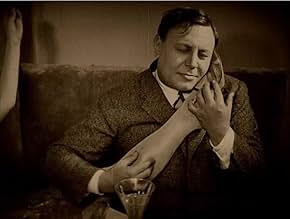PUNTUACIÓN EN IMDb
7,4/10
1,4 mil
TU PUNTUACIÓN
"Boss", quien ha pasado diez años en la cárcel y lleva un espectáculo barato con su mujer, añora su vieja vida de glamour con el circo."Boss", quien ha pasado diez años en la cárcel y lleva un espectáculo barato con su mujer, añora su vieja vida de glamour con el circo."Boss", quien ha pasado diez años en la cárcel y lleva un espectáculo barato con su mujer, añora su vieja vida de glamour con el circo.
- Premios
- 3 premios en total
The Flying Codonas
- Acrobatic Ensemble
- (as Die Drei Codonas)
Argumento
¿Sabías que...?
- CuriosidadesAmerican humorist S. J. Perelman was so taken with this movie he wrote about it 40 years later in an essay entitled "And, in the Center Ring, That Stupendous Death-Defying Daredevil..." He said "Alfredo Cordona, the wizard of the flying rings, and his partners doubled for the actors. I saw the picture four times, reacting so volcanically to Cordona's forward triple somersault that I almost rent the chair in front of me to matchwood."
- ConexionesEdited into Prisoner of Paradise (2002)
Reseña destacada
The male flyer initially appears in cinema as a flawed hero. The prototypes are characters found in Variety (1925), directed by Ewald Dupont and based on Felix Hollaender's novel, The Oath of Stephen Huller.
This is a semi-expressionist film about a heavy-bodied catcher-husband, Boss Huller (Emil Jannings), whose wife, Bertha-Marie (Lya de Putti), is seduced from domestic bliss by the trio's lighter-bodied star flyer, Artinelli (Warwick Ward). The cather-husband imagines dropping his rival, the flyer, but murders him instead in a fight, and goes to prison. The seducing male flyer is the provocateur of extreme passion, a position subsumed by female aerialist characters in later films. But the male aerialist as a criminal, even murderer, intermittently reappears in representation because he epitomizes a capacity for extreme risk-taking, which is translated into socially risky immoral behavior. But it is the male flyer who becomes especially vulnerable to depiction as a fallen hero, literally and for losing emotional control.
Although little-known today, Variety is one of the major works of German Expressionism. It's an immorality of emotion drama with a fine performance by (the always great) Jannings and the wonderful visual film-making that is the hallmark of the Expressionist movement (extraordinary cinematography by Karl Freund). Variety was heavily censored for its American release; how it was changed makes it almost as interesting as a case study in film censorship as it is enjoyable as a movie.
In its original version, the film begins with a drawn-out portion showing how Emil Jannings falls in love with Lya De Putti, left his wife for her, and created a trapeze act with his lover. This part of the story was excised completely by the American censors, and title cards added to redefine Jannings and De Putti as the married couple of the U.S. release version. The censors' intent was to erase the plot point of casting adulterous lovers as the established couple in a love triangle. The effect was to far more radically transform the story. The unfaithful husband who is in his turn betrayed by his unfaithful lover is transformed into a sympathetic cuckold. The opportunistic temptress who catches two men only to end up with none is transformed into a young wife who succumbs to temptation. From unsparing morality play to conventional melodrama, courtesy of censorship.
This is a semi-expressionist film about a heavy-bodied catcher-husband, Boss Huller (Emil Jannings), whose wife, Bertha-Marie (Lya de Putti), is seduced from domestic bliss by the trio's lighter-bodied star flyer, Artinelli (Warwick Ward). The cather-husband imagines dropping his rival, the flyer, but murders him instead in a fight, and goes to prison. The seducing male flyer is the provocateur of extreme passion, a position subsumed by female aerialist characters in later films. But the male aerialist as a criminal, even murderer, intermittently reappears in representation because he epitomizes a capacity for extreme risk-taking, which is translated into socially risky immoral behavior. But it is the male flyer who becomes especially vulnerable to depiction as a fallen hero, literally and for losing emotional control.
Although little-known today, Variety is one of the major works of German Expressionism. It's an immorality of emotion drama with a fine performance by (the always great) Jannings and the wonderful visual film-making that is the hallmark of the Expressionist movement (extraordinary cinematography by Karl Freund). Variety was heavily censored for its American release; how it was changed makes it almost as interesting as a case study in film censorship as it is enjoyable as a movie.
In its original version, the film begins with a drawn-out portion showing how Emil Jannings falls in love with Lya De Putti, left his wife for her, and created a trapeze act with his lover. This part of the story was excised completely by the American censors, and title cards added to redefine Jannings and De Putti as the married couple of the U.S. release version. The censors' intent was to erase the plot point of casting adulterous lovers as the established couple in a love triangle. The effect was to far more radically transform the story. The unfaithful husband who is in his turn betrayed by his unfaithful lover is transformed into a sympathetic cuckold. The opportunistic temptress who catches two men only to end up with none is transformed into a young wife who succumbs to temptation. From unsparing morality play to conventional melodrama, courtesy of censorship.
- Ziggy5446
- 27 ene 2008
- Enlace permanente
Selecciones populares
Inicia sesión para calificar y añadir a tu lista para recibir recomendaciones personalizadas
Detalles
Taquilla
- Recaudación en Estados Unidos y Canadá
- 709.613 US$
- Duración1 hora 44 minutos
- Mezcla de sonido
- Relación de aspecto
- 1.33 : 1
Contribuir a esta página
Sugerir un cambio o añadir el contenido que falta
































